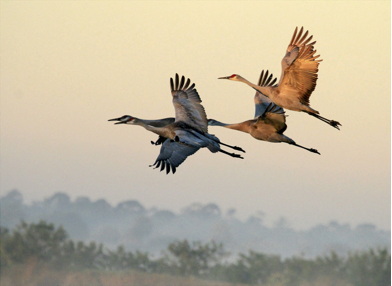The Wolsey Important Bird Area (IBA) in eastern South Dakota provides critical resting, refueling and staging habitat for over 150,000 Sandhill Cranes each spring including nearly 40% of all Greater Sandhill Cranes and over 23% of the global population of all six subspecies of Sandhill Cranes (Krapu et al. 2014).
These majestic birds soar into South Dakota on thermal updrafts to utilize Wolsey IBA’s 1.6 million acres of productive wetlands, marshes, uplands and croplands during spring migration. The cranes use Wolsey IBA as a staging area where they rest and forage for nearly two weeks each spring. In traditional staging areas, such as the Central Platte River Valley (CPRV) in Nebraska, forage resources and suitable habitat have been decreasing due to land use changes. As an apparent result, 40% of Sandhill Cranes have moved their daytime foraging to north of the CPRV (Krapu et al. 2014), specifically within the Wolsey IBA region. Therefore, protection of the Wolsey IBA and other northern crane stopover sites is of critical importance and has led to Audubon Dakota’s and partners’ conservation goal of protecting and enhancing 22,000 acres of Sandhill Crane stopover habitat by 2025.
To this end, in September 2017, Audubon Dakota received its first North American Wetland Conservation Act (NAWCA) grant of $1 million for the South Dakota Wolsey IBA Habitat Conservation (SDWIHC) Project Phase I. Grant funds are dedicated to purchasing perpetual easements on 1,491 grassland acres and 91 wetland acres in 2018 within the project area counties (Aurora, Beadle, Davison, Faulk, Hand, Hanson, Hyde, Jerauld, Miner, Potter, Sanborn, Spink, and Sully). Project partners include South Dakota Game, Fish and Parks, James River Watershed Development District, Ducks Unlimited, US Fish and Wildlife Service, and Brad Freeman, a private contributor. With the success of SDWIHC Phase I, Audubon Dakota and partners submitted a funding request for Phase II in February 2018. It was approved by the NAWCA Council in June 2018 and will support the protection of an additional 1,170 grassland acres and 170 wetland acres within the project area.
Audubon Dakota and the US Fish and Wildlife Service Huron Wetland Management District have developed a strategy for protecting the highest use areas for cranes and other waterfowl within the project area. As stated by Krapu et al. (2014) “…protecting key roosts or other important habitats can be accomplished most effectively through use of conservation easements.”
Therefore, at the heart of this effort is a partnership with willing private landowners interested in voluntarily enrolling in the conservation easement program. If interested in enrolling, please contact Huron Wetland Acquisition Office (Realty) 605-352-7014.
Krapu, G. L., D. A. Brandt, P. J. Kinzel, and A. T. Pearse. 2014. Spring migration ecology of the mid-continent Sandhill crane population with an emphasis on use of the Central Platte River Valley, Nebraska. Wildlife Monographs. Vol. 189. https://doi.org/10.1002/wmon.1013

